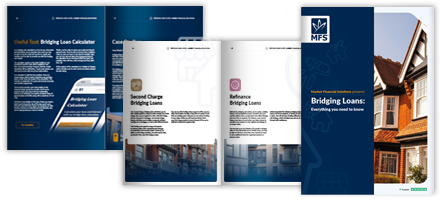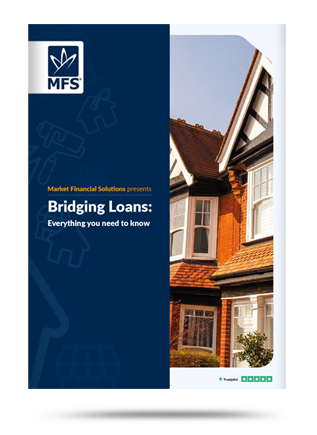Market Financial Solutions are a bridging loan and buy-to-let mortgage provider and are not legal, financial, investment or tax advisers. This document is for informational purposes only and does not, and should not be considered, to constitute legal, financial, investment or tax advice or be relied upon by any person to make a legal, financial, investment or tax decision. Therefore, Investors are encouraged to seek appropriate professional advice. The information in this content is correct at time of writing.

Exit strategies are a crucial element of specialised finance. Given the short-term nature of the bridging world, you’ll need to have at least an idea of how you intend to repay a loan before funds are issued. These repayment plans are what’s known as exit strategies. In this blog, we’ll break down exactly what bridging loan exit strategies are, while exploring the options available to investors.
What Is a Bridging Loan Exit Strategy?
Exit strategies broadly define the plans borrowers put in place to repay their bridging loan. Specialist finance helps bridge the gap between property purchases for buyers who need quick results. But the funding issued is designed to be short-term in nature, with the terms typically lasting just a few months.
As such, borrowers are expected to have a clear plan to switch to a long-term financial solution ahead of time. Often, no funding will be lent until this plan is firmly established. The actual long-term financial solution can come in many different formats.
Types of Exit Strategies
Two of the most common exit plans are refinancing and resale strategies. Specialist finance can be used by those seeking to buy a house, extend a leasehold or make investments in the property market. A bridging loan can keep a deal from falling through while the buyer works with long-term lenders to lock in refinancing plans for the coming years.
Resale exit strategies can be utilised by those in a chain where purchases and sales may be out of sync. This could be due to unforeseen problems or delayed paperwork. Regardless, a bridging loan can help cover the costs until sale deadlines are ironed out and a clear exit is found.
While many buyers will utilise these bridging loan exit strategies, there are other methods for covering your finance. A variety of cash redemptions can be used, so long as they’re secured and planned out. This can include funds from a pension lump sum, investment sale or even an inheritance. Exit strategies can even be secured with the sale of certain physical assets, such as classic cars or artwork.
Developers, or those with basic refurbishment plans, may also utilise “fix and flip” exit plans. Buyers may want to buy a property, do it up, and then put it back on the market to sell or rent out. Lenders can accept these plans but will need to assess how much work on the property is needed, demand in the wider market and other factors.

What Are the 5 Exit Strategies – a Refresh
We’ve covered some of the basics of specific exit strategies, but it’s worth going over a few more details for each. It’s the details which will prove important for investors as no two cases will ever be the same, and lenders review deals based on their individual merits.
1. Traditional Long-Term Finance
Getting a mortgage is one of the most popular ways to exit a short-term loan. Here, the key element to remember is timings. Bridging loans can be issued in mere days, whereas traditional finance can take months to set up. Additionally, those seeking out buy-to-let mortgages may also have to factor in rental payments ahead of time.
Some long-term lenders may require evidence of rental income before issuing funds, usually over the course of 3 or 6 months. This is to prove that the monthly income generated by the property is high enough to cover the repayments. Bridging finance can help borrowers purchase a property, get the required monthly income, then proceed with their long-term lender. The Market Financial Solutions buy-to-let products also allows rolled and deferred interest to be implemented, which can facilitate the purchase of a property without current tenants – this can allow for works to be done, or the right tenants to be found first.
2. Sale of a Property
Using the sale of one asset to pay for another is a common bridging loan exit strategy, often utilised by investors with larger property portfolios. Here, the main challenge will probably be securing a buyer. Once an offer is locked in however, lenders can be flexible with the remaining details.
3. Refurbishing and Reselling an Asset for a Profit
Refurbishing property can range between small decorative tweaks to installing entirely new rooms. Often, the increase in value after a refurbishment can cover both the purchase and work costs. As such, exit strategies based around refurbishments can be viewed as particularly sound.
4. Cash Settlements
Cash sitting in a bank account may not have many strings attached, creating an easy way out for investors and lenders alike. Lenders will likely just want to see evidence of where the cash is – or will be – coming from. Borrowers may need to remember where they’ve kept probate documents or share certificates.
5. Development Exit Finance
Property developers will be the ones most likely utilising development exit strategies. A development exit loan is a way to avoid costly development finance loan repayments once units are complete, with the bridging loan itself being the exit strategy. Property developers can use the bridging loan funds to repay their development finance loans.
This provides developers with more time to find buyers, without the need of reducing prices to sell quickly. They can also use the time to get long term finance on the assets dependent on their end goal…
Why Do You Need a Bridging Loan Exit Strategy?
Investors may understand what exit strategies are, but they may be unclear on just how important they are. Exit strategies provide a crucial level of security for both the lender and borrower. Having a clear exit strategy will result in fewer costs for the borrower. The rates involved are more likely to be lower with exit plans in place, while borrowers are less likely to build up arrear charges.
Pros and Cons of Having an Exit Strategy
Aside from the lower costs, those with clear exit strategies may be looked on favourably by lenders. Generally, lenders are more likely to offer loans for cases where exit plans are in place.
Some may be willing to issue funds to cases where the exit strategy is open-ended. For a few borrowers without confirmed deadlines – builders and the like – this flexibility could prove useful.
Also, while good lenders will be adaptable, strictly sticking to an exit strategy could be stifling for those whose plans change. If a borrower initially plans to exit a loan through a house sale, but instead wants to shift to utilising inheritance money, it could raise alarm bells for some lenders who’ll want to stick to what was originally agreed to.
How to Plan a Bridging Loan Exit Strategy
Investors should consider their timelines before seeking out a loan. Understanding, realistically, how long a project will take may help map out a timeframe for repayments. Knowing exactly why they’re investing will also be important.
It can be easy to simplify a plan to: “I want to make money”. After all, what are exit strategies for if not to lock in profits? But how this is accomplished will be a deciding factor. Are you investing in a residential property to let out, or buying a commercial lot to expand a business? Asking these questions ahead of time will help investors evaluate if there’s demand in the wider market. Finding renters may take weeks, whereas rebuilding a business could take months – if not years.
When planning, it can also be worthwhile to come up with a range of potential exit strategies where possible. Lenders may not accept an initial exit plan they’re presented with, so having backups could pay dividends. At the very least, lenders may be reassured the borrower has done their homework and is prepared.
Ultimately, the success of investing in property with bridging finance will depend on how a buyer exits a loan. Specialist finance can help secure a win in the short term, but this does not mean investors should rest on their laurels. Knowing how to focus on long-term gains as opposed to quick turnarounds will mark the difference between successful investors, and those who struggle to keep up with their overheads. As we’ve demonstrated, lenders can provide plenty of flexibility in how loans are exited, but it will be up to individual buyers to act and be decisive in how they get things done.
The Complete Guide to
Bridging Loans
Everything you need to know
- Different bridging types
- Useful tools
- Apply them in real life
- Market insights & more





